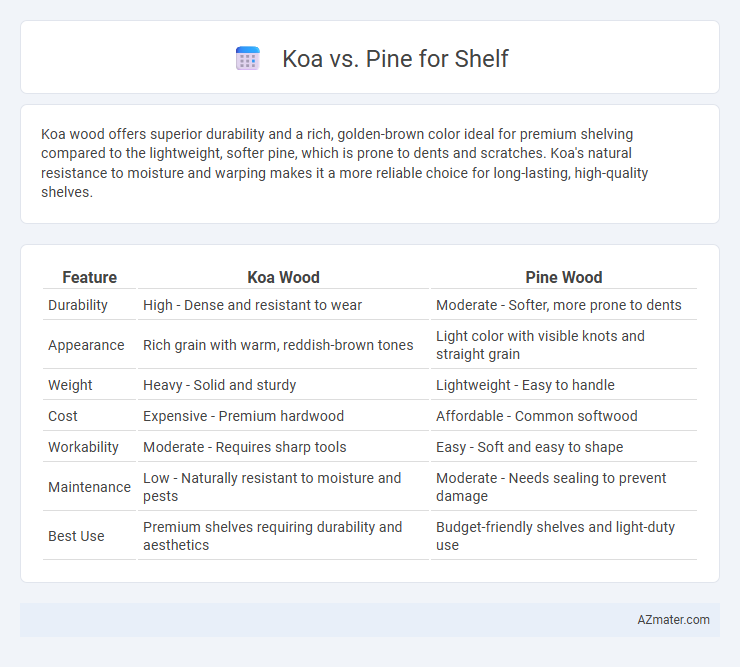Koa wood offers superior durability and a rich, golden-brown color ideal for premium shelving compared to the lightweight, softer pine, which is prone to dents and scratches. Koa's natural resistance to moisture and warping makes it a more reliable choice for long-lasting, high-quality shelves.
Table of Comparison
| Feature | Koa Wood | Pine Wood |
|---|---|---|
| Durability | High - Dense and resistant to wear | Moderate - Softer, more prone to dents |
| Appearance | Rich grain with warm, reddish-brown tones | Light color with visible knots and straight grain |
| Weight | Heavy - Solid and sturdy | Lightweight - Easy to handle |
| Cost | Expensive - Premium hardwood | Affordable - Common softwood |
| Workability | Moderate - Requires sharp tools | Easy - Soft and easy to shape |
| Maintenance | Low - Naturally resistant to moisture and pests | Moderate - Needs sealing to prevent damage |
| Best Use | Premium shelves requiring durability and aesthetics | Budget-friendly shelves and light-duty use |
Overview: Comparing Koa and Pine for Shelving
Koa offers a rich, warm tone and durability ideal for premium shelving that requires both strength and aesthetic appeal. Pine, being softer and more affordable, is favored for lightweight shelving with a natural, rustic look. While Koa provides superior resistance to wear and moisture, Pine is easier to work with and finishes well with various stains and paints.
Physical Properties: Koa vs Pine Wood
Koa wood is denser and harder than pine, offering greater durability and resistance to scratches for shelves. Pine wood is lighter and softer, making it easier to work with but more prone to dents and wear over time. The rich grain and warm tones of koa provide a more luxurious aesthetic, while pine's pale color allows for versatile staining and painting options.
Durability and Strength Differences
Koa wood offers exceptional durability with a Janka hardness rating of around 1,200, making it highly resistant to dents and scratches, while Pine scores significantly lower at approximately 420 on the Janka scale, indicating softer and more easily marred surfaces. The dense grain structure of Koa provides superior strength and stability, which makes it ideal for heavy-duty shelving capable of supporting substantial weight over time. Pine, although more affordable and easier to work with, lacks the same load-bearing capacity and is more prone to wear, making it better suited for lightweight or decorative shelving.
Appearance and Aesthetics
Koa wood features a rich, warm golden-brown hue with unique, intricate grain patterns that deepen in color over time, offering a luxurious and natural aesthetic for shelves. Pine presents a lighter, creamy-yellow tone with simpler, straight grain lines that provide a rustic, clean, and bright appearance ideal for casual or country-style interiors. The choice between Koa and Pine depends on whether the design preference leans toward elegant richness or light and airy simplicity in shelf aesthetics.
Workability and Ease of Installation
Koa wood offers superior workability due to its fine grain and moderate hardness, making it easier to cut, shape, and finish for shelf projects. Pine, being softer and lighter, allows for straightforward installation with common tools, providing flexibility in nailing or screwing shelves into place. Both woods balance ease of installation with functional workability, but Koa grants a smoother finish, while Pine is more cost-effective and widely available.
Cost Comparison: Koa vs Pine Shelves
Koa shelves typically cost significantly more than pine shelves due to the rarity and premium quality of Koa wood, often priced at $50 to $100 per board foot compared to pine's $2 to $5 per board foot. Pine shelves offer affordability and versatility, making them a popular choice for budget-conscious projects without sacrificing basic durability. The higher cost of Koa reflects its aesthetic appeal, density, and natural resistance to wear, justifying its use in high-end or decorative shelving solutions.
Sustainability and Environmental Impact
Koa wood, sourced primarily from Hawaii, is prized for its rapid growth and renewable qualities, making it a sustainable option for shelving that supports forest conservation efforts. Pine, widely available and fast-growing, offers a low environmental footprint due to its ability to regenerate quickly and absorb significant carbon dioxide during growth. Both woods provide eco-friendly choices for shelf construction, with Koa excelling in durability and unique grain patterns while pine offers affordability and efficient resource use.
Maintenance and Longevity
Koa wood offers moderate maintenance requirements with natural oils that provide some resistance to moisture and pests, but it may need periodic sealing or oiling to maintain its appearance and durability. Pine requires more frequent maintenance due to its softer nature and higher susceptibility to dents, scratches, and environmental damage, often needing regular sealing or protective finishes to prevent wear. In terms of longevity, koa is significantly more durable and long-lasting compared to pine, making it a better choice for shelves intended for heavy use or long-term durability.
Ideal Uses and Applications
Koa wood is prized for its rich, warm color and fine grain, making it ideal for high-end furniture, musical instruments, and decorative shelves where aesthetics and durability are paramount. Pine offers a lightweight, cost-effective option with a pale finish, suited for functional shelving, rustic interiors, and DIY projects requiring easy customization and quick installation. Both woods provide versatility, but Koa excels in luxury applications, while Pine is preferred for economical and adaptable shelving solutions.
Final Verdict: Choosing Between Koa and Pine for Shelves
Koa wood offers a luxurious, golden-brown hue with a smooth, tight grain, making it ideal for high-end, visually striking shelves that demand durability and elegance. Pine, known for its light color and soft texture, provides an affordable, versatile option that is easy to work with and suitable for rustic or casual shelving solutions. The final verdict depends on the desired aesthetic and budget, with Koa favored for premium, long-lasting displays and Pine chosen for cost-effective, adaptable shelf projects.

Infographic: Koa vs Pine for Shelf
 azmater.com
azmater.com